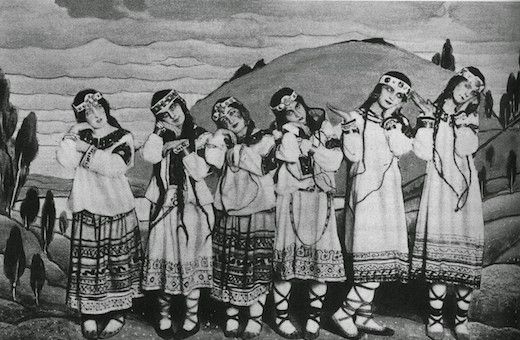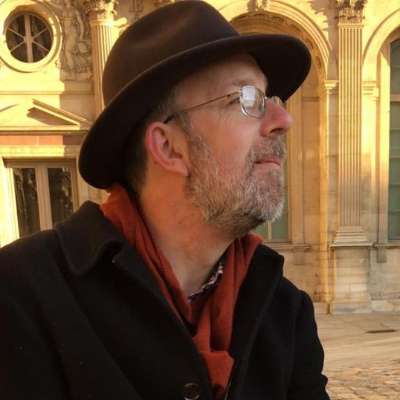Although several events in Coco Chanel & Igor Stravinsky are fictitious – including their alleged affair – the 2009 film opens with a dramatic extended sequence depicting one of the most famous evenings in music history. It is the 29th of May 1913 and the well-heeled audience gathers at the Théâtre des Champs-Élysées for the world premiere of a new ballet, Le Sacre du printemps. The composer paces the corridors, Pierre Monteux urges his players to forget melody and follow his beat. The boos, hisses and whistles that follow are the stuff of legend, so uproarious that choreographer Vaslav Nijinsky is forced to count out the beat in the wings because the dancers cannot hear the music.

“It was as if the theatre had been visited by an earthquake: it seemed to be literally shaking,” wrote journalist Valentine Gross, who recorded the premiere in sketches. “People were screaming insults, booing, whistling, drowning out the music completely. There were slaps, blows, even fistfights.” Giacomo Puccini, who attended the second performance, described the choreography as ridiculous and the music as cacophonous, “the work of a madman”. The ‘Riot at The Rite’ was a true succès de scandale. Impresario Serge Diaghilev could not have wished for better publicity. Over a century on, it’s a work that still has the power to shock. Here, conductors Vasily Petrenko and Esa-Pekka Salonen offer insights, while Tamara Rojo reflects on one of the most powerful choreographies, the version by Pina Bausch.
Where did The Rite spring from? Sacre was Stravinsky’s third ballet (after Firebird and Petrushka, also for Diaghilev’s Ballets Russes). The concept was developed by Nicholas Roerich, an expert on folk art and ancient rituals, who provided the stage and costume designs for the ballet, subtitled “Pictures of Pagan Russia in Two Parts”, depicting a primitive springtime ritual where a young girl is chosen as a sacrificial victim who then dances herself to death. Stravinsky claimed that the idea for Sacre came to him in a dream but, as Richard Taruskin points out in a 2012 article for The New York Times, this was “typical of a man who spent the second half of his life telling lies about the first half.”
Stravinsky’s dissonances, irregular metres, stresses and cross-rhythms caused huge problems for early orchestras. Pierre Monteux never warmed to the work. In old age he said, “I did not like Le Sacre then. I have conducted it fifty times since. I do not like it now.” Listen to early recordings and you can hear the struggle, but today youth orchestras play it at the drop of a hat.
“That’s a demonstration of just how much orchestral techniques have progressed,” Vasily Petrenko tells me over Skype. “But it requires a lot of rehearsal. With professional orchestras, it’s still an iconic piece. The players always look forward to it, to put all those rhythmic patterns in place, to feel this burst of energy.”
In a spoken introduction to his Los Angeles Philharmonic recording, Esa-Pekka Salonen claimed that Sacre is still a challenge. “It’s never easy to conduct, it’s never easy to play. It’s full of traps and hair-raisingly difficult things. The main thing about this music is that every time I look at the score or rehearse it or hear it, I’m struck by the incredible freshness of expression, the immediate power of this music and it hasn’t lost anything over the years – it’s still very much alive and kicking.”
Conducting Sacre is also physically demanding. “When you come to the sacrificial dance, 26 or 27 minutes into the piece,” Petrenko relates, “by this point you are sweating so much that you can barely see anything, so you need to know that part by memory! Once you do it more and more, I wouldn’t say I barely break a sweat but experience and knowledge of the piece helps.”
“When we come to the last few bars before the Danse sacrale starts I feel this surge of adrenalin – it’s like a stress reaction, like an animal – and I love it because it keeps me alive,” says Salonen.
But despite the score – which still has the power to shock in the concert hall – it was Nijinsky’s choreography that really fired up the Parisian audience at the premiere. Stravinsky had expressed his doubts early on. Nijinsky was famous as a dancer, but had done little choreography. His erotic writhing in L'Après-midi d'un faune had met with mixed success in 1912 and Jeux, his ballet charting the hide-and-seek shenanigans in the search for a lost tennis ball, had flopped at the Champs-Élysées just 14 days before the premiere of Sacre. “The poor boy knew nothing of music. He could neither read it nor play any instrument.”
I recall seeing a reconstruction of Nijinsky’s choreography when the Mariinsky Ballet brought it to Covent Garden. Expecting to be as shocked by the choreography as by the music, I was hugely disappointed. “But you’ve seen a lot of post-Rite choreography, Mark” scolds Petrenko. “You must not forget how revolutionary it was at the time!”
Tamara Rojo is in agreement. “I have seen a couple of recreations,” she tells me, “and I do think we need to look at them with some trepidation regarding their accuracy. But I also think we need to look at this piece within its historical context. It is more than a hundred years old, created only 15 years after Petipa created Raymonda, and the primitive style of the choreography, although now dated, must have created a huge visual impact at the time.”
True, but I have some sympathy with the composer who later ridiculed Nijinsky's dancing maidens as “knock-kneed and long-braided Lolitas”. The Sacre choreography that has most overwhelmed me was Pina Bausch’s iconic 1975 version for Tanztheater Wuppertal, where the barbaric ritual plays out on an earth-covered stage. I described it in my 2019 review at Sadler's Wells:
“Bausch physicalises Stravinsky’s earthy score in a visceral, shattering way. As the bassoon unfurls its wailing solo, a single woman is resting on a scarlet slip, like spilt blood. She seems to be the guardian of the dress, protecting it. Other women join her, darting into beams of light, convulsed with fear. They know what’s coming; motifs of breast-beating and self-flagellation recur throughout... In Part 2, the Chief selects the Chosen One – several women present themselves, holding the red slip, until he suddenly, violently clutches one by the shoulders. Bausch asked: 'How would it be to dance knowing you have to die? The Chosen One is special, but she dances knowing the end is death.'”
Rojo, Artistic Director of English National Ballet, secured the rights for her company to present the work – a huge honour only otherwise afforded to the Paris Opéra Ballet (where I’ve also seen it danced). What makes Bausch’s version so special? “For me this is without a doubt the ultimate version,” says Rojo. “It has the courage to face upfront the meaning and the violence inherent in the music and the act. Somehow Pina managed to make it incredibly modern in its vocabulary and physicality while being completely timeless in its humanity.”
“It is an incredibly demanding piece for everyone involved, from the scheduling and the amount of time it requires for a company to be completely dedicated to one singular piece of repertoire, to the musicians of the orchestra that have to play such an iconic score, to the crew and technical team and, of course, the dancers. It is one of the most physically and psychologically demanding pieces for any dancer to face.
“I was completely overwhelmed with pride and gratitude every single time the company performed it! To have achieved this incredible artistic landmark and to have the complete trust and approval of the Pina Bausch team was one of the most special moments in my life.”


